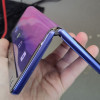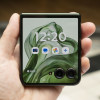JavaOne 2006
May 18, 2006, 6:18 PM by Eric Lin
On-the-scene report from the JavaOne conference in San Francisco. Hands-on with the Nokia 5500 Sport and SavaJe Jasper S20.
Nokia 5500
I have always wished that there was a "rugged prosumer" category for personal electronics. Some of us are just harder on our gear than the average user who rarely uses his gadgets or always uses the included cases when he does. The new Apple MacBook might fit this category, and the same can be said for the Nokia 5500. With S60 3rd Edition, a screen bigger than most S60 V2 handsets and a 2 megapixel camera, no one will doubt that this smartphone has solid features. But the rubberized body and keyboard, small size and durable materials make this phone solid physically as well.
The 5500 is much smaller than you might think; it's barely larger than the average candybar phone, and certainly smaller than the average ruggedized handset (other than the 5140, which was about the same size). It has an hourglass shape like the 3220 that allows you to hold on to phone firmly. On each of the bulges along the side are buttons buried below the surface of the rubber, like the side buttons on the Sidekick II. On the left are volume keys and a Push To Talk button, which are clustered close enough together that it's easy to press the wrong key by accident. On the right are the pencil (text options) key, which is nicely tucked away from the keypad until you need it, and the "quick mode" key.
The quick mode key instantly switches you from the standard smartphone mode to the music player and the fitness application; and when we say instantly, we mean it. There is no noticeable delay when changing modes. The music player is the same one as on all S60 V3 phones, including the N80 we previewed recently. The fitness app will track the distance and time you've traveled (presumably exercising) using a pedometer linked to a timer. It can track and store your progress over months.
All of the keys on the keypad are protected by a rubber surface except for the send and end keys, which are two hard nubs that are raised higher than the rest of the keys. The keys are easy to use, and texting was fast.
Our only complaint about the 5500 was that the screen was small and dim, a bit like old Series 40 square screens. Although the screen may be transflective so it works outdoors, it was a bit disappointing when shown next to the (admittedly much more fragile) brilliant screens of the new Eseries and Nseries phones.
Still it was easy to see the 5500 being the right smartphone for a number of people. It is small, durable, fast and has a good camera and media player - and it doesn't feel overwhelmingly complicated like smartphones, even most S60 smartphones.
SavaJe S20
After years of development, the SavaJe OS is finally out. SavaJe showed us a phone running the OS back at CTIA, but it wasn't an official SavaJe phone, nor was it the final version of the OS, so we didn't feel comfortable talking about it, which was good because we weren't really impressed. But somehow, SavaJe has come a long way in 5 weeks, and are showing off a much more refined OS in their first phone.
The Group Sense Jasper S20 is not exactly an impressive handset based purely on looks and specs. It reminds us of a Nokia 6620 crossed with a W800. It is a tri-band GSM phone with a 176 x 220 screen, Bluetooth 2.0, a 1.3 Megapixel camera and MiniSD card slot. But in this case, it's what's inside that counts.
It's not that the S20 has a superfast processor or runs some fancy hardware, it's that the SavaJe OS has a lot of power in a little space. The entire OS is based on a full implementation of standard Java - not just mobile Java (MIDP) - so it offers full Java power in a mobile device. It does of course still run MIDP 2 applications like many other phones.
The S20 has SavaJe's first UI, one created in partnership with Group Sense. It is easy to use, although not exactly visually engaging. The main menu and standard applications have a simple navigation system and obvious controls and text fields. SavaJe recently hired a team of experienced designers to redesign the interface, and they will move into a new Palo Alto office next week. Version 2 should bring some big improvements.
SavaJe already has designed a few interfaces along with some partners that take advantage fo the OS's power and really show off the phone. The application switcher, photo gallery, and even an add-on music player (it comes with a standard one that is rather plain) all use a carousel layout to spin images, similar to S60's last gallery application or their new web browser. However the speed with which the SavaJe phone can rotate through the carousel and switch tasks or open photos blows away what we've seen on other phones. And we're told that the Jasper S20 is only running a 150 MHz ARM 9 processor.
The S20 will launch in Hong Kong this summer, and SavaJe expects to launch additional handsets later this year. If the new handsets also include a new, more graphically rich interface and menus, they are sure to capture some attention provided the handsets themselves are also updated to a more current design.
(video no longer available)

QuickTime format
MIDP 3.0
The actual big Java news at the show was not any new handsets, but the new "open sourcing" of the next mobile Java version, called both JSR 232 and MIDP 3.0. Nokia, Motorola, and SavaJe all talked about the new Java movement.
Java creator Sun, along with major manufacturers and developers, have all gotten together in a public setting - the "open source" aspect of this endeavor - to determine and approve exactly what will be in this next version of mobile Java. Anyone can submit improvements or feature requests until the spec is locked down, and approved, which is expected to happen this fall. Once MIDP 3.0 is approved, all participating manufacturers have agreed to implement the spec on their phone without any changes. This means that for the first time ever, developers will actually be able to write once, run anywhere. Until now, many manufacturers have added their own special code to their Java engines to accelerate graphics or allow other functionality. With that functionality built into MIDP 3, manufacturers will be able to follow the common standard.
Developers have been requesting that manufacturers do this for ages, but for the most part, no one was really listening to the developers. But developers have become more powerful, and manufacturers don't want a developer to leave support for their phone out of a popular game or application.
What really has lit a fire under this project is the fact that carriers are now customizing handsets with their own applications, and they don't want to have to develop multiple version of the same application. Since carriers are manufacturers' real customers, the manufacturers are listening.
In addition, carriers are telling manufacturers that if they don't have to test handsets for Java compatibility with their application library, that it will shorten a notoriously long phone testing and approval process. Phones could launch sooner after they are announced. The pressure from both carriers and developers was enough to convince Sun and the manufacturers that something had to be done.
If MIDP 3 is approved this fall as expected, we will most like likely see the first MIDP 3 phones launching in the second half of next year.
Comments
question about the nokia's durbility (for the mods)
has there been any bumps bruise or drop demonstrations you can tell us about?
(continues)
So...Java, huh?




















 TCL's New Foldable Concept Swings Both Ways
TCL's New Foldable Concept Swings Both Ways
 Hands On with the 2023 moto g 5G & moto g stylus
Hands On with the 2023 moto g 5G & moto g stylus
 Hands On with the moto g stylus 5G (2023)
Hands On with the moto g stylus 5G (2023)
 Hands On with the Motorola razr and razr+ (2024)
Hands On with the Motorola razr and razr+ (2024)
 Hands On with the HMD Fusion and its Smart Outfits
Hands On with the HMD Fusion and its Smart Outfits

